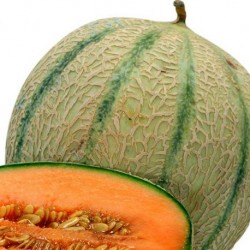



Charentais is a heirloom cantaloupe type melon. Ideal if you trying to grow melons the first time. Medium sized fruits with grey - green skin and orange flesh. The flowers attract bees and other benefical insects love them.
Sweet, fragrant cantaloupes are one of the fruits that are best grown in a personal garden. Supermarket melons are weak in comparison, as they are picked before the fruits are fully ripe to accommodate for transportation to your store. Cantaloupes from your garden can come to full maturity on the vine and are sweeter, juicier and way tastier than anything you can buy. If you think cantaloupes are bland or boring, you need to grow your own and experience their true rich and delicious flavor. Check out all of our melon seeds, we have watermelons seeds too for greenhouse growing.
Named for the papal gardens of Cantalupo, Italy, where it is thought they originated, and cantaloupes are a heat-loving, tender fruit that need a little bit of extra care for optimum quality and taste.
Planting
Plant cantaloupes in well-drained, rich soil. They need lots of sun so pick a good spot without any shade.
Cantaloupes need temperatures between 21-32C to germinate properly. Sow seeds outdoors when the soil temperature is at least above 18C and all danger of frost has passed. If the soil it too cool, it encourages soil borne root diseases to take hold. These can stunt a melons growth or completely decimate the plant.
Plant your cantaloupe seeds in groups of 3-4 seeds, 1/2” deep. Groups should 18-24 inches apart and rows are 5-6 feet apart. Once the seedlings get to 2 inches tall, thin the groups, keeping only the strongest two seedlings.
Melons can be started indoors and then transplanted, however they are extremely sensitive to root disturbance so if you do this, use caution. If the roots get damaged, the plants growth will be stunted. Start seedlings indoors 2-4 weeks before you intend to transplant them. To avoid the possibility of root disturbance as much as possible, plant the cantaloupe seeds in biodegradable containers, like peat pots, which can be planted into the garden right along with the seedling. Cantaloupe seedlings are ready to be transplanted when they have 2-3 mature leaves. Place transplants 2 feet apart in your garden. A bonus to starting seedlings indoors is that you can add 2-4 weeks to the growing season.
Watering & Care
Cantaloupes need a good soil soaking of 1-2 inches a couple times a week. When the fruits begin to ripen, reduce the amount of watering. Over-watering at this stage may cause the melons to split. Additionally, cutting back on the watering will improve the cantaloupe's flavor.
If there is a cold spell, or you are planting your melons a little on the early side, place row covers over your seedlings. This will keep the cold out and also protect the seedlings from any insects on the prowl. Remove row covers after the plants flower or if the weather turns really hot before that so the seedlings don't get cooked.
If you have a small garden space, or are trying to fit as many plants into your garden as possible, cantaloupes can be trellised. You will need to train the long viney shoots to climb the trellis or fence and then once the fruits begin to get large, place a support underneath the fruit so they don't damage the vines with their weight.
Melon roots do not go deep into the soil, so you will need to be extra careful when weeding. Carefully hoe or pull up weeds around the plants without getting too close to them. It is best to do this frequently so the weeds don't get too large and cause a large disturbance to the soil when they are removed. When the vines start to cover more ground, it may be necessary to do all weeding by hand to protect the shallow roots of the melons.
Harvest
Cantaloupes are ready to be picked when the curly string-like tendrils on the fruit near the stem turn brown and dry out. The fruit will have changed from green to tan to yellow and the skin will become dull. The outer skin will also be covered in a coarse, rough, netting.
When the cantaloupe is fully mature, the stem will break off easily from the vine. Do not let them release from the vine on their own; they need to be picked. Twist the fruit carefully at the vine and remove.
One of the benefits of growing your own cantaloupe is that you can let it ripen completely before picking. It is called a 'full slip' when the fruit reaches it's maximum ripeness and sugar content on the vine. Most commercial growers pick their melons before reaching this stage, sometimes even at a 'half slip', which means the fruits are only half way ripened. Since the sugar content does not increase after the melon is harvested, the melons we get in the supermarket are not fully ripe and at their highest quality.
Check every other day for ripe cantaloupes at the beginning of the season. During peak season, check every day. If melons are left too long, they might get discovered by wildlife and insects, drawn to the sweet, juicy melon flesh.
Store cantaloupes in a cool place for 1-2 weeks. They can be refrigerated or kept in a room at this temperature. They will start to get squishy and rotten as they age so be sure to cut them open and eat them as soon as possible.